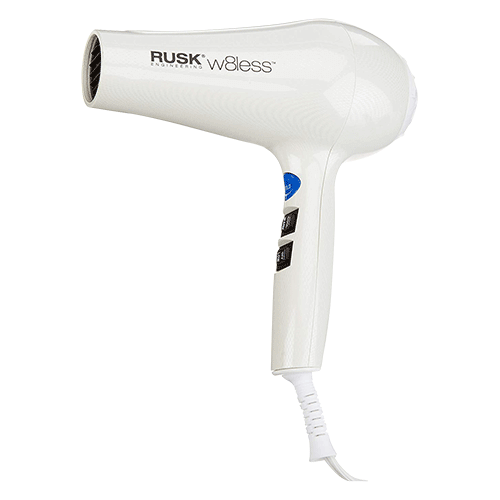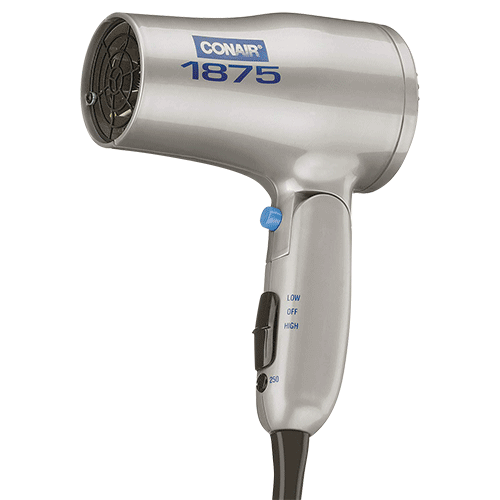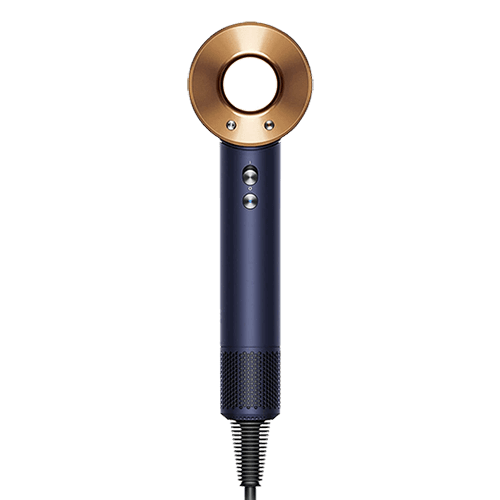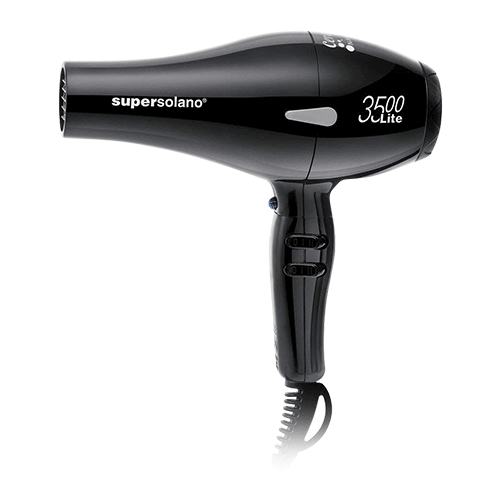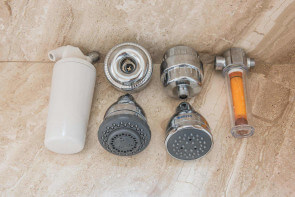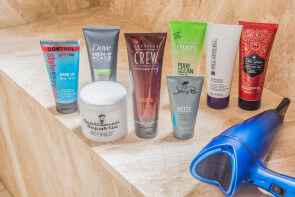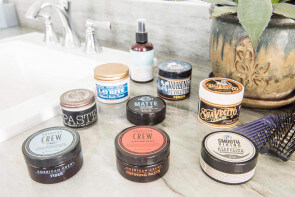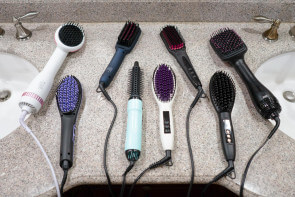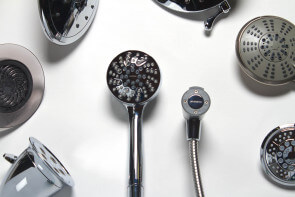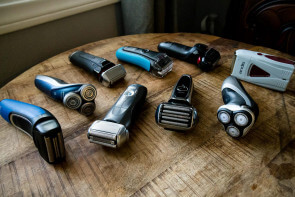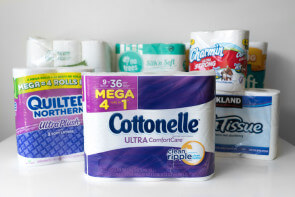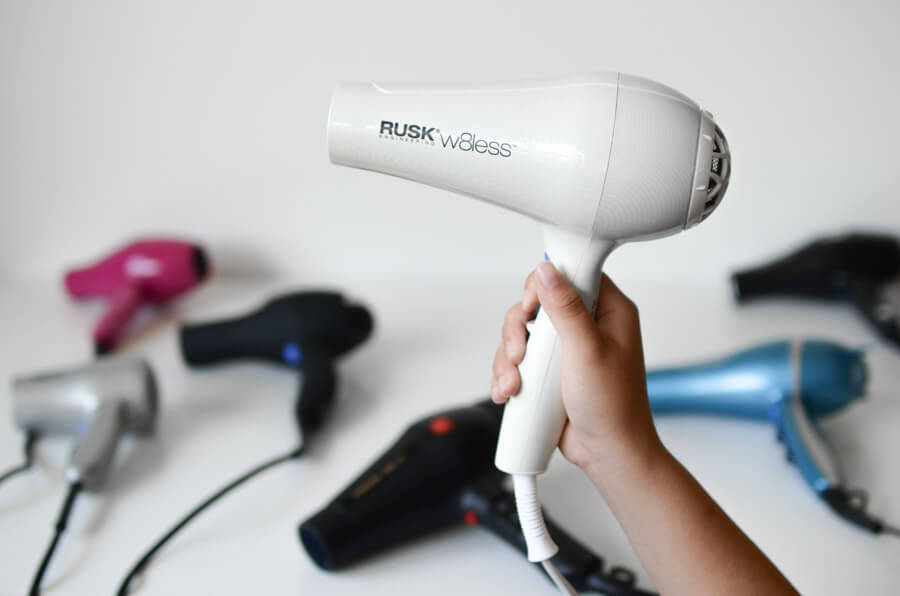
The 8 Best Hair Dryers
Over the course of a month, we spent 30 hours on research and even more on testing our seven finalists. While everyone’s hair needs are different, we feel confident in recommending the Rusk – W8less as the best hair dryer. It features ionic, ceramic and tourmaline technology for those with damage-prone hair. Plus, it packs plenty of wattage, heat and wind power for those with thick hair. For frequent travelers, look to the dual-voltage and lightweight Conair – 1875. For an effective but pricey upgrade, we loved the Dyson – Supersonic hair dryer.
Over the course of a month, we spent 30 hours on research and even more on testing our seven finalists. While everyone’s hair needs are different, we feel confident in recommending the Rusk – W8less as the best hair dryer. It features ionic, ceramic and tourmaline technology for those with damage-prone hair. Plus, it packs plenty of wattage, heat and wind power for those with thick hair. For frequent travelers, look to the dual-voltage and lightweight Conair – 1875. For an effective but pricey upgrade, we loved the Dyson – Supersonic hair dryer.
Table of contents
- The 8 hair dryers we tested
- Best overall: Rusk – W8less
- Best for travel: Conair – 1875
- Upgrade pick: Dyson – Supersonic
- Other products we tested
- How we selected
- How we tested
- Important features to consider
- The bottom line
The 8 hair dryers we tested
| Product | Price | Advertised Watts | Weight (lb) | Cord Length | Motor Type |
|---|---|---|---|---|---|
| 1. RUSK - W8less | $$ | 2000 | 1.0 | 8' - flat | DC |
| 2. Xtava - Peony (discontinued) | $ | 1875 | 0.9 | 8' 2" - round | AC |
| 3. Conair - 1875 | $ | 1875 | 1.3 | 6' - flat | AC |
| 4. BaBylissPRO - Nano Titanium | $$ | 2000 | 1.8 | 8' 6" - flat | DC |
| 5. Conair - Infiniti Pro | $ | 1875 | 2.6 | 6' - flat | AC |
| 6. Twinturbo - 3200 | $$$ | 1900 | 1.5 | 9' - round | AC |
| 7. Super Solano - 3500 lite | $$$$ | 1800 | 1.0 | 11' - round | DC |
Best overall: Rusk – W8less
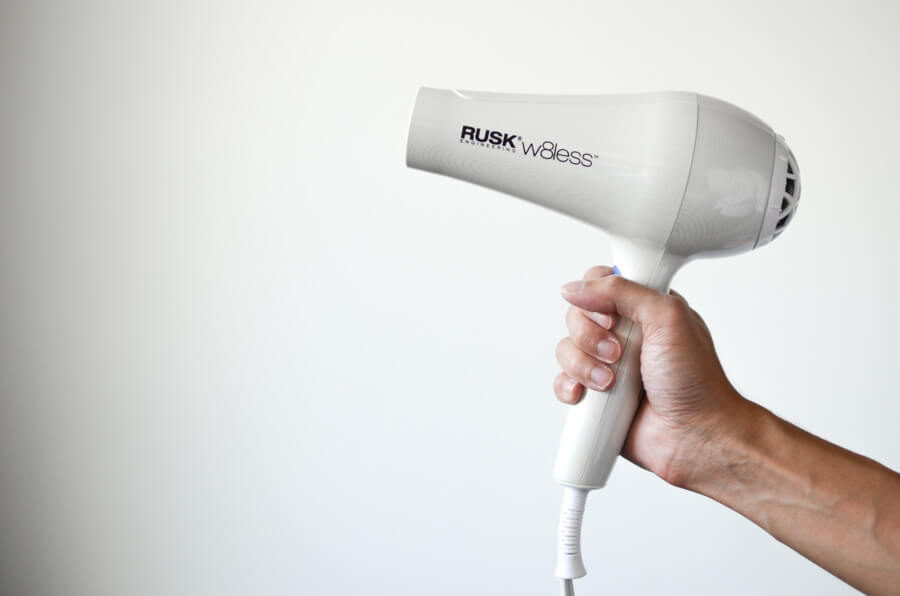
The Rusk – W8less has nearly everything you could want in a hair dryer. Infused with ceramic and tourmaline, it emits far-infrared heat and negative ions for a faster, gentler blow dry. The far-infrared heat penetrates the hair cuticle to dry hair from the inside out, so it’s less damaging to the hair structure. With tourmaline technology, millions of negative ions break down the water molecules so hair dries faster and is exposed to heat for less time. All of this leads to healthier hair and a shinier, smoother finish.
The Rusk is extremely efficient, producing the greatest air velocity of all our finalists and testing at 1555 W. Even with all that power, it was one of the quietest dryers we tested. It has high heat capabilities for when you need to remove excess moisture or have thicker hair that takes ages to dry. Plus it only weighs a pound, so you aren’t tempted to give up the job halfway through.
A trend with the professional models is to have unlabelled settings, but this isn’t the case with the Rusk. The three heat and two-speed settings plus a cold shot button are clearly labeled so there’s no question which setting you’re on.

At 8’, the cord length is average among the finalists we tested and the lightweight, ergonomic design of the Rusk makes it comfortable to use. In fact, the only part of the design we would change would be to add a hanging loop for storage and use a round cord for less tangling.
While our finalists all produced similar results, the Rusk did seem to have an edge on combating frizz on curly hair, which we attributed to the tourmaline technology.
Key takeaways:
- Thanks to ceramic and tourmaline dryer technology, the Rusk – W8less is effective on thick hair yet gentle enough for fine or delicate hair.
- Possessing a high wattage and wind speed, the Rusk still managed to be one of our quietest dryers.
- The Rusk weighs only a pound, so you can hold your arms overhead without getting tired.
- The ergonomic design of the Rusk and clearly labeled buttons make this hair dryer comfortable and simple to use.
Best for travel: Conair – 1875
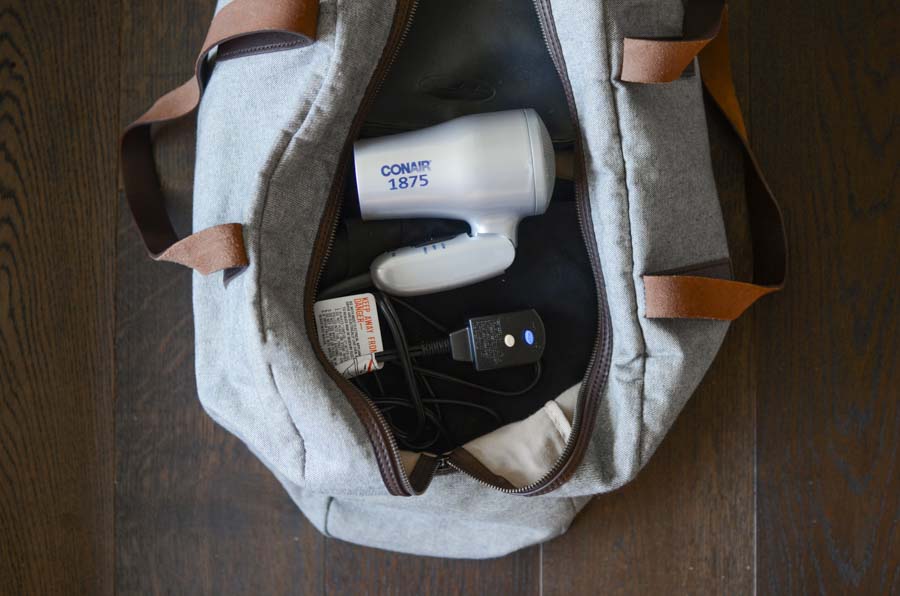
Since the Conair – 1875 is dual voltage, you won’t need a converter to use it overseas. All you’ll need is an adaptor to change the shape of the plug. It has a patented “twist it” folding handle, so it folds down to approximately 4.5×5” and fits conveniently in a carry-on bag. Priced under $20 at the time of publication, it won’t break the bank if you accidentally leave it behind in a hotel.
With such a low price point and compact size, we wondered how it would measure up to our full-size dryers in testing. We were pleasantly surprised that it parallelled the Rusk in terms of temperature, and performed on par or better than some of our professional dryer finalists when it came to wattage.
One drawback was that it performed significantly lower in the wind speed test than our other finalists. When combined with its high temperature, this means that the Conair – 1875 could have a tendency to over-dry your hair. However, since it does have ionic technology and therefore a faster drying time, your hair is exposed to the heat for less time. A majority of consumers on Amazon rated it five stars and were pleased with its power.
The Conair – 1875 has two heat and speed settings, plus a cool shot feature. One thing we didn’t love about the Conair – 1875 is that it doesn’t come with any attachments, such as a concentrator. It was much harder to direct the airflow downward (the proper angle for straightening hair with a round brush) without a concentrator. On the plus side, that’s just one less thing you have to pack in your bag.
Key takeaways:
- Dual voltage is the most convenient feature of the Conair – 1875, allowing you to dial to the correct voltage setting (125 or 250) for worldwide use.
- Despite its small size, its high heat setting was hotter than the majority of our finalists.
- Featuring patented “twist it” technology, the Conair – 1875 can fold down to half its size so it takes up less room in your luggage.
- The Compact weighs just over a pound, so it won’t have much effect on luggage weight limits.
Upgrade pick: Dyson – Supersonic
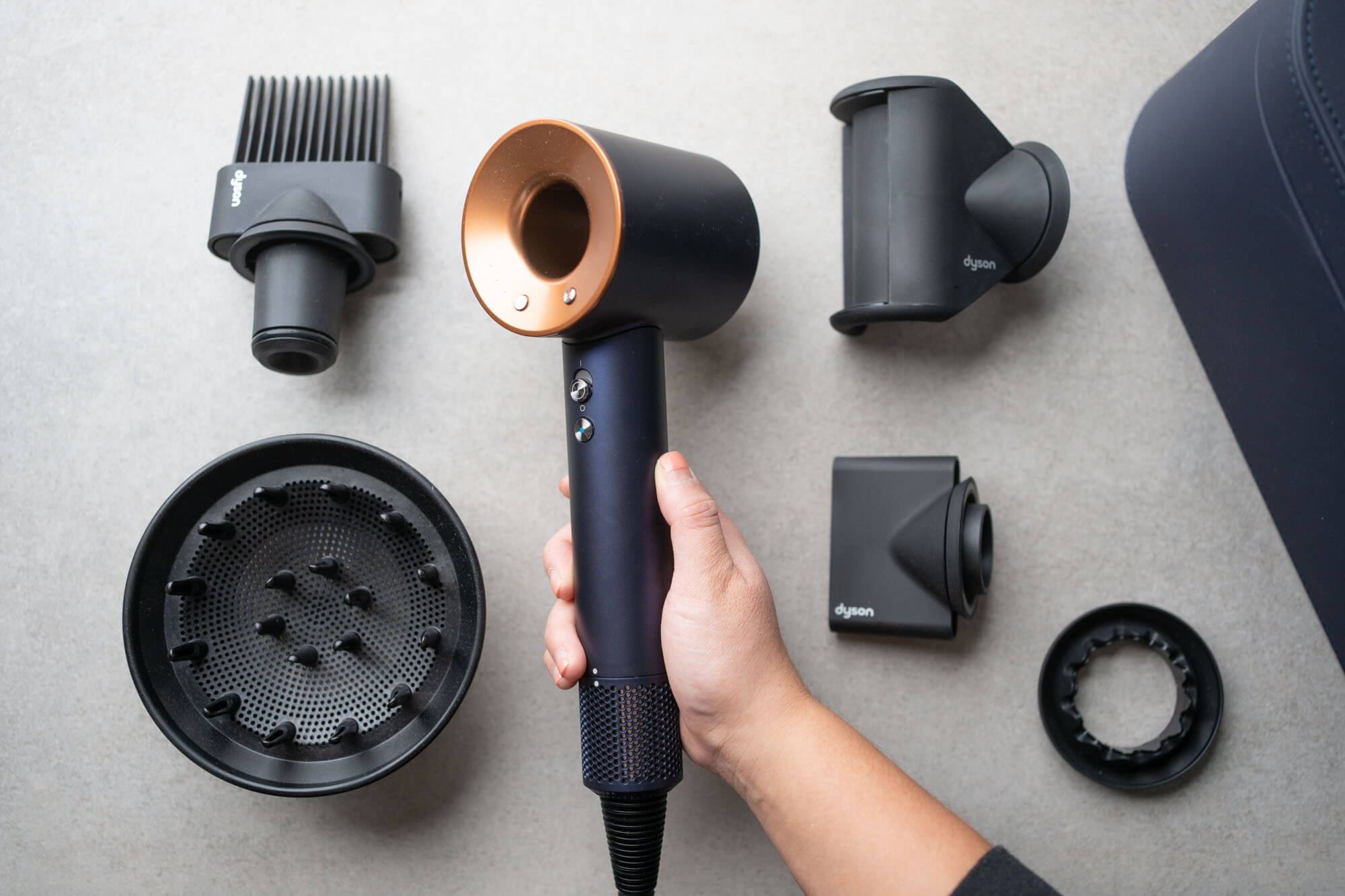
The Dyson – Supersonic hair dryer is our upgrade pick because its innovative design creates high-velocity speeds to dry your hair more quickly than other dryers we tested. It also prevents temperatures from going beyond 302 ℉ – a threshold that Dyson states begins to damage hair. After testing this hair dryer on thick type 2A hair, we found it completely dried hair within four minutes without going over 212 ℉.
This hair dryer has five attachments that help with styling hair types, from curly to straight or frizzy. We loved the newly designed Flyaway attachment that helps smooth out frizzy hairs–a feature we’ve never seen previously on any other hair dryer.
Unlike other hair dryers we reviewed, the Dyson Supersonic hair dryer was the only tool that tested at a higher wattage (1714 W) of power than advertised (1600 W). It’s a powerful styling tool equipped with Air Multiplier technology and intelligent heat control to keep hair healthier.
At $599, this hair dryer is significantly more expensive than our other picks; however, we recommend this as our upgrade pick because it kept our hair healthy, and styling was faster than other hair dryers even with thick, type 2A hair.
Best for heavy use: Super Solano – 3500

In print, the Super Solano – 3500 has features to make it stand out: lightweight, ceramic, tourmaline, an Italian-made motor. In reality, the Super Solano didn’t live up to our expectations. When we performed our comparison tests, we found it to have the lowest wattage, the lowest temperature on its highest heat setting, and the loudest motor. Likely due to the low wattage, it tested at a less-than-average wind speed. Plus, it had the highest price point among our finalists.
It does have the widest range of heat settings since you can combine heat and speed settings for more temperatures. So if you have fine, delicate hair that warrants a lower temperature and don’t mind spending the extra money, this dryer could work for you. It also has an 11’ round cord and hanging loop, which were definite selling points, but not enough to name it a top pick.
Other products we tested
BaBylissPRO – Nano Titanium
The BaBylissPRO Nano Titanium beat out the other finalists in terms of wattage and heat. It also possesses serious wind speed and has an ergonomic design. It’s the only dryer we tested with nanotechnology and titanium parts, so it stands out in a class of its own. Nanotechnology manipulates atoms and molecules, and in a hair dryer, is used to remove odors and microbes on the scalp. Titanium is a metal that maintains a high constant temperature, which definitely proved true in our testing with an infrared heat thermometer.
Although titanium distributes heat evenly and keeps the temperature steady, the higher temperature can distress fine or fragile hair. The BaByliss is also our second heaviest dryer, weighing nearly two pounds. For these reasons, the BaByliss narrowly missed the mark as our top pick. It was definitely our pick for runner-up however and would make an excellent choice if you have tons of hair that can handle a very hot dryer.
Conair – Infiniti Pro
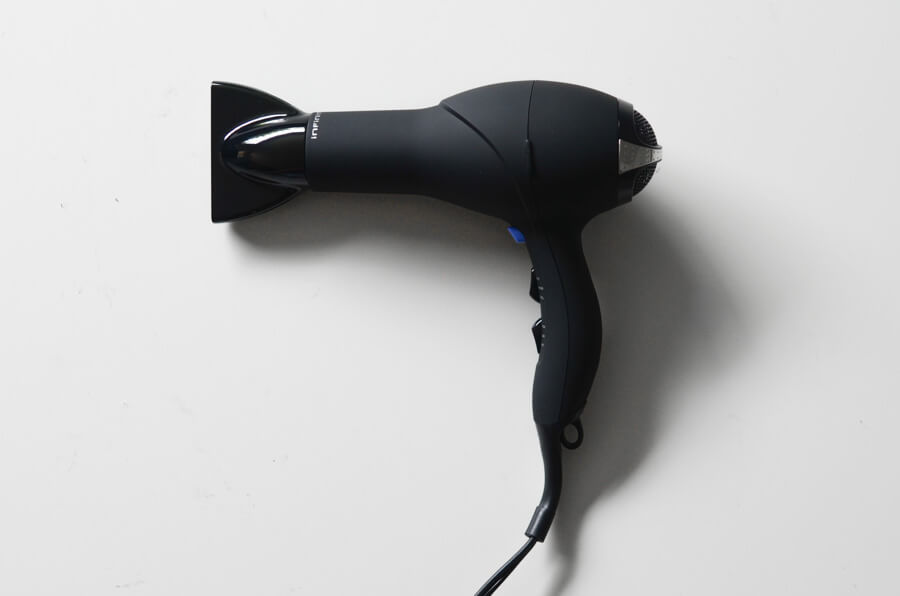
For a drugstore hair dryer at a budget price, the Conair Infiniti Pro has a lot to offer. It has a long-lasting AC motor, meaning you’ll get your money’s worth out of the Infiniti Pro before it needs replacing. It has ionic and ceramic technology for healthier and less frizzy hair, which is another way it rivals the professional models. In our tests, it performed on par with the other finalists and was one of the quietest dryers we tested.
While the Infiniti Pro is a great deal and beloved by at least a few fashion magazine editors, we didn’t choose it as our budget pick due to its uncomfortable weight. At 2.6 pounds, it was the heaviest hair dryer among our finalists, and we definitely felt it in our wrists and biceps after using it. On the other hand, if you really want a workout, this may be the perfect blowdryer for you.
Twinturbo – Turbo Power 3200
The Twinturbo – Turbo Power 3200 has an Italian-made, K-Lamination® AC motor, which has been recently improved to be lighter and consumes less than energy. So while it has a high price point, it’s sure to last you for a long time. In fact, the manufacturer claims that it has a motor life of 2000 hours, which is double the usual lifespan of an AC motor. It features ceramic and ionic technology and a nickel-chrome heating element for faster drying times and less hair damage. The Twinturbo also has a safety thermostat that prevents overheating.
Despite the reputation for design and technology that Italian motors are known for, the Twinturbo had the second-lowest wattage of the models we tested. Combining this factor with its moderate heat and wind speeds, we didn’t feel the Twin Turbo justified its high price point.
How we selected
Since the results from a hair dryer can be relative (hair length, texture, and condition play an important role in finding the right tool), we first read articles explaining the complex structure of hair and the factors behind hair damage. Then we carefully considered consumer opinions from a variety of sources, including subreddits like /r/HaircareScience/ and /r/curlyhair/ and style blogs. We looked at the hair dryer review from The Sweethome, which influenced our decision to include the Xtava.
Next we headed over to Amazon, where we narrowed our choices down to the dryers that were rated highly by more than 100 reviewers. With enough consumer data, we knew we had opinions covering a wide variety of hair textures and types.
Once we chose our finalists and had a solid understanding of which features are most important to consumers, we headed to the bathroom for some hands-on testing. For each hair dryer, we used four different types of meters (thermometer, anemometer, wattage meter, and decibel meter) a head of wet hair to determine which hair dryer was at the top of its class.
How we tested
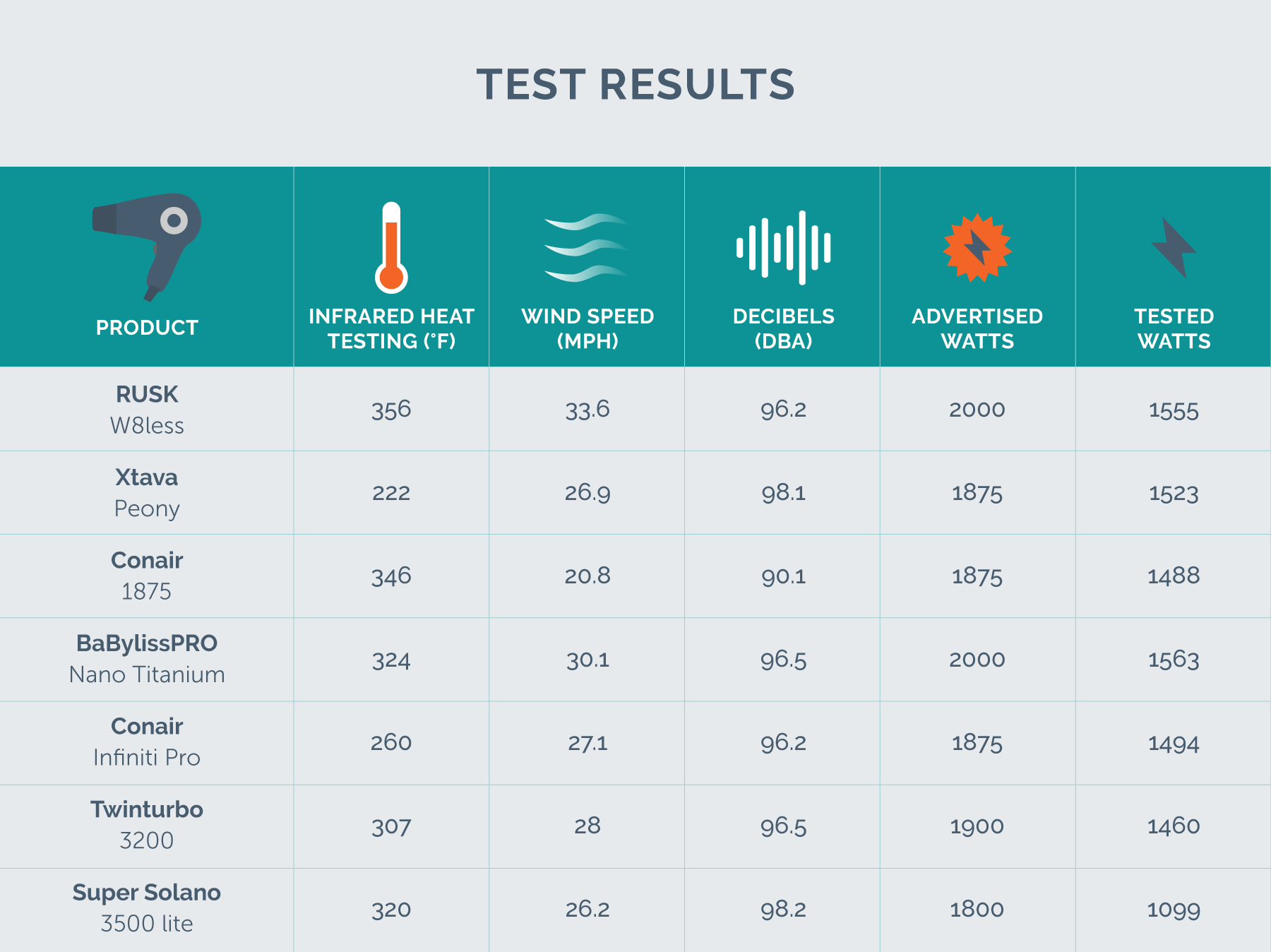
Hands-on testing
Since hair dryers will often try to sell you on the fact that their model will make your hair look amazing, we took each of our finalists out for a spin to see if they lived up to they hype. Over the course of three weeks, we incorporated each finalist into our morning routine to see if we were out the door faster or if our hair looked smoother.
We put our finalists to work on both fine, curly hair (read: prone to frizz) and thick hair, and were surprised to find that the dryers were basically equal in terms of drying time and results. This may be due to the fact that we narrowed down our finalists to those with higher-quality heating elements made with ceramic or titanium, but we had comparable results with the technology-free Xtava.
We did notice a major difference in using a concentrator since it’s harder to control where the air is directed without one. This was one downside to the Conair – Compact, which doesn’t come with a concentrator. On curly hair, the dryers with tourmaline technology like the Rusk – W8less and Super Solano – 3500 did seem to combat frizz better than our other finalists.
Over the years, we’ve used a few cheap hair dryers that produced bad results and we can happily report that there were no “hat days” with our finalists. On the other hand, expecting any of these dryers to magically transform your hair is a bit of a stretch. The true magic lies in healthier hair since the cuticle lies flatter and reflects light better. So as long as you’re not actively damaging your hair with your hair dryer, you should see healthier hair and better results emerge over time.
It’s worth noting that in an interview discussing the secret behind her company’s raved-about blowouts, Drybar founder Alli Webb mentions the amount of time spent perfecting each section, the angle of the dryer, and hair products mattered more than the actual hair dryer (even though she has one on the market).
Infrared heat thermometer

In order to gauge the heat output of each dryer, we used an infrared thermometer to accurately measure the temperature at the highest setting. For the test, we held the thermometer six inches away from the hair dryer and pointed it directly at the center of the nozzle. At 82.4 °F, the BaBylissPRO reached the highest temperature of all the dryers we tested. The Conair and Rusk came in next, both reaching a peak temperature of 80.2 °F. The dryer with the lowest high heat setting was the Super Solano, which only reached 76.2°F.
While blasting your hair with the highest heat setting isn’t the best idea if you have fine or fragile hair, high heat will help you remove excess water from your hair. Drying faster also means that you are exposing your strands to heat for less time.
Wind speed

Celebrity hairstylist Kristen Ess points out that without the wind power associated with a strong motor, hair is essentially toasted with heat. Keeping this in mind, we used the anemometer to check the air flow velocity of each dryer. We held the anemometer six inches away from the dryer (which is the distance that you should keep your dryer at all times) and pointed the nozzle directly at the meter.
Our findings were that Rusk boasts the most wind power at 33.6 mph. A close second was BaBylissPRO at 30.1 mph. The remaining finalists fell in the 20-28 mph range, with Conair – 1875 having the least amount of wind power at only 20.8 mph.
Wattage

The other benefit to a high-wattage dryer is that they last longer, so you get more for your money. According to Allure, you’ll get the speediest results using a hair dryer with at least 1800 watts. Each of our finalists are marketed at 1800 watts or more, but we wanted to see how this actually played out once we plugged it into our Kill A Watt Electricity Usage Monitor and tested them all on the highest settings. Interestingly, none of the numbers we came up with matched the claims, but we did get an idea of which dryers had the strongest motors.
The BaBylissPRO tested at the highest wattage (1563 W) and the Rusk came in a close second (1552 W). Which didn’t surprise us, since they both rated the highest in wind power and heat. The dryer with the lowest wattage was the Super Solano 3500. As a professional-quality hair dryer, it did surprise us that this rated far lower than our other non-professional finalists, including the store-brand Conair dryers.
Noise levels

Since loud noises in small spaces can be particularly annoying, we wanted to see which of our finalists had the quietest motor. We used a GoerTek sound decibel meter to test each dryer at a distance of six inches, the distance it would most likely be from your ear. At 90.1 decibels, the quietest dryer was the Conair – 1875, which is one of the reasons we chose it as our frequent flier pick. If jet lag keeps you up at night, you can feel free to take a shower and blow-dry your hair without disturbing the other hotel guests.
The Rusk and Conair Infiniti Pro tied for second place in this test, but they were still 6.1 decibels louder than the Conair – 1875. The loudest dryer was the Super Solano, so don’t choose it if you have roommates that like to sleep in late.
Usability
When you’re juggling a round brush in one hand and a blow-dryer in the other (especially if it’s before you’ve had your morning coffee), the last thing you want is a heavy dryer that will make your arms ache. Ideally, a dryer that weighs around a pound is your best option. The longer it takes your hair to dry, the more important this factor becomes. With this in mind, we graphed the weight of each hair dryer to see which dryers balanced power with weight.
The lightest hair dryer we tested was the Xtava, which weighs less than a pound and still measured at 1523 W. It was also the most comfortable and convenient to use with its curved handle and 360-degree swivel cord. A close second was the Rusk, which only weighs a pound and tested at 1555 W. On the other end of the spectrum, the Conair – Infiniti Pro weighed an uncomfortable 2.6 pounds.
How to properly dry your hair
Most of us use a hair dryer in order to save time in the morning or to straighten or style our hair with heat. After all, wet hair just isn’t a professional look (neither is running in late to a meeting), and some mornings you don’t have time to wait for your hair to air dry.
You might think you’re sacrificing your hair’s health when you blow dry it, but that isn’t the case. According to Prevention.com, using a hair dryer at the right distance and temperature is actually the healthiest way to dry your hair. Why? The hair cuticle is a protective outer layer that is held together by delicate proteins. When water causes the strands to swell for an extended period of time, it puts pressure on those proteins and leads to damage. If your hair is already damaged, it is even more porous.
Therefore, blow-drying your hair properly can lead to healthier strands that are less likely to break. What is the magic formula? Let your hair dry most of the way naturally (about 70-80% dry). Then use the coolest setting and continuous motion to finish the job. Make sure to hold the dryer at least six inches away from your hair.
How to choose one based on hair type
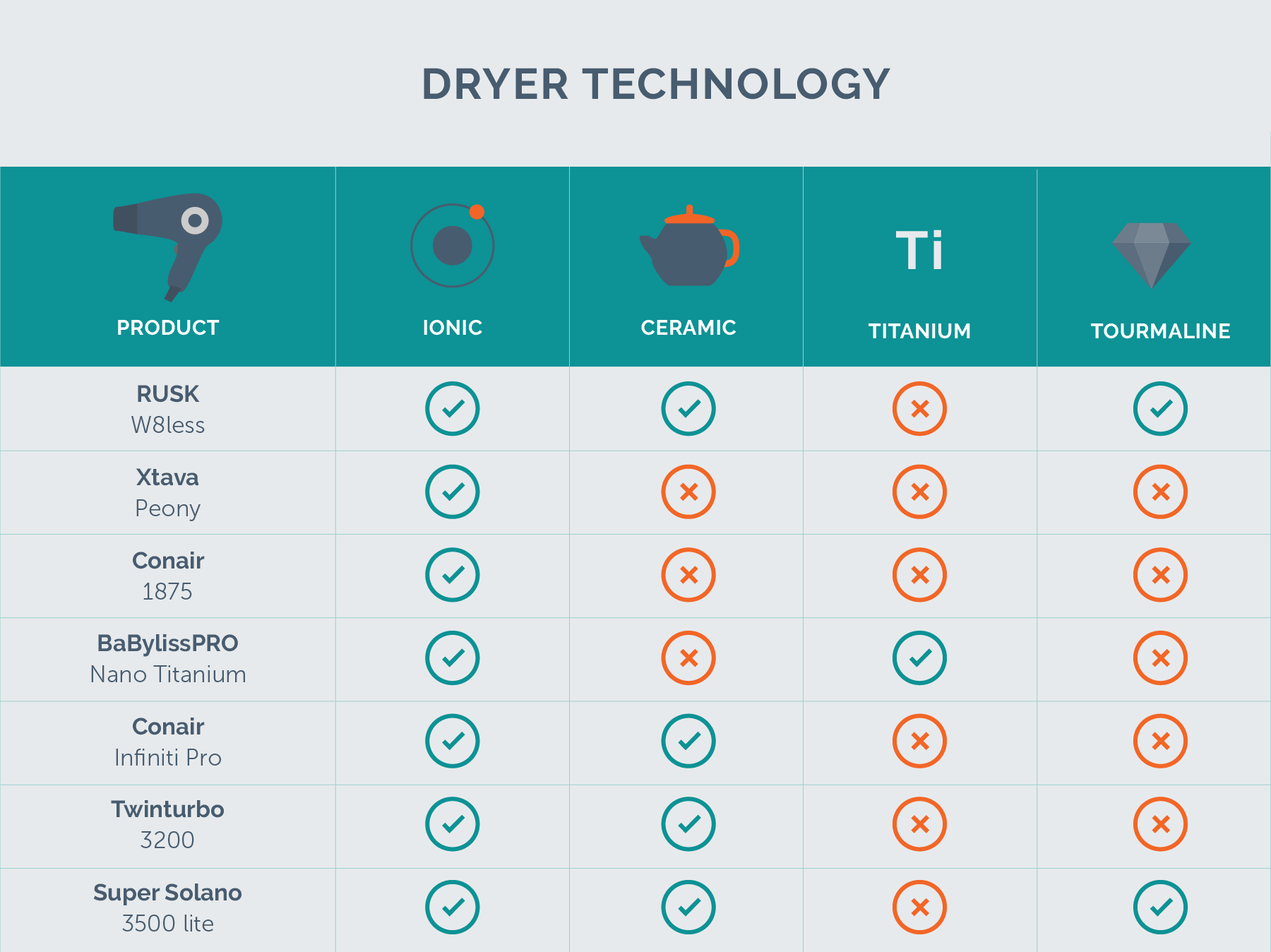
The key to finding the top performer is to find one with features for your hair type. Hairstylist, Josue Perez, recommends adjusting the heat level to your hair texture and condition. High heat is best suited for thick or coarse hair, while a cooler temperature is better for fine or damaged hair.
If you have thick hair that takes a long time to dry, investing in a high-wattage dryer is essential. If your hair tends to frizz, you’ll want an ionic dryer (or even better, a dryer with tourmaline technology). On the other hand, celebrity stylist, Peter Butler, points out that a non-ionic dryer is better for flat hair that needs more texture and movement. The best results come from using the dryer that causes the least amount of damage to your hair since the appearance of shine and smoothness comes from the condition of the hair cuticle.
Wondering whether to spend the extra money on a professional dryer? Here’s a consideration: professional hair dryers produce greater air velocity, have hotter temperatures, and have more durable housing than their drugstore counterparts.
Important features to consider
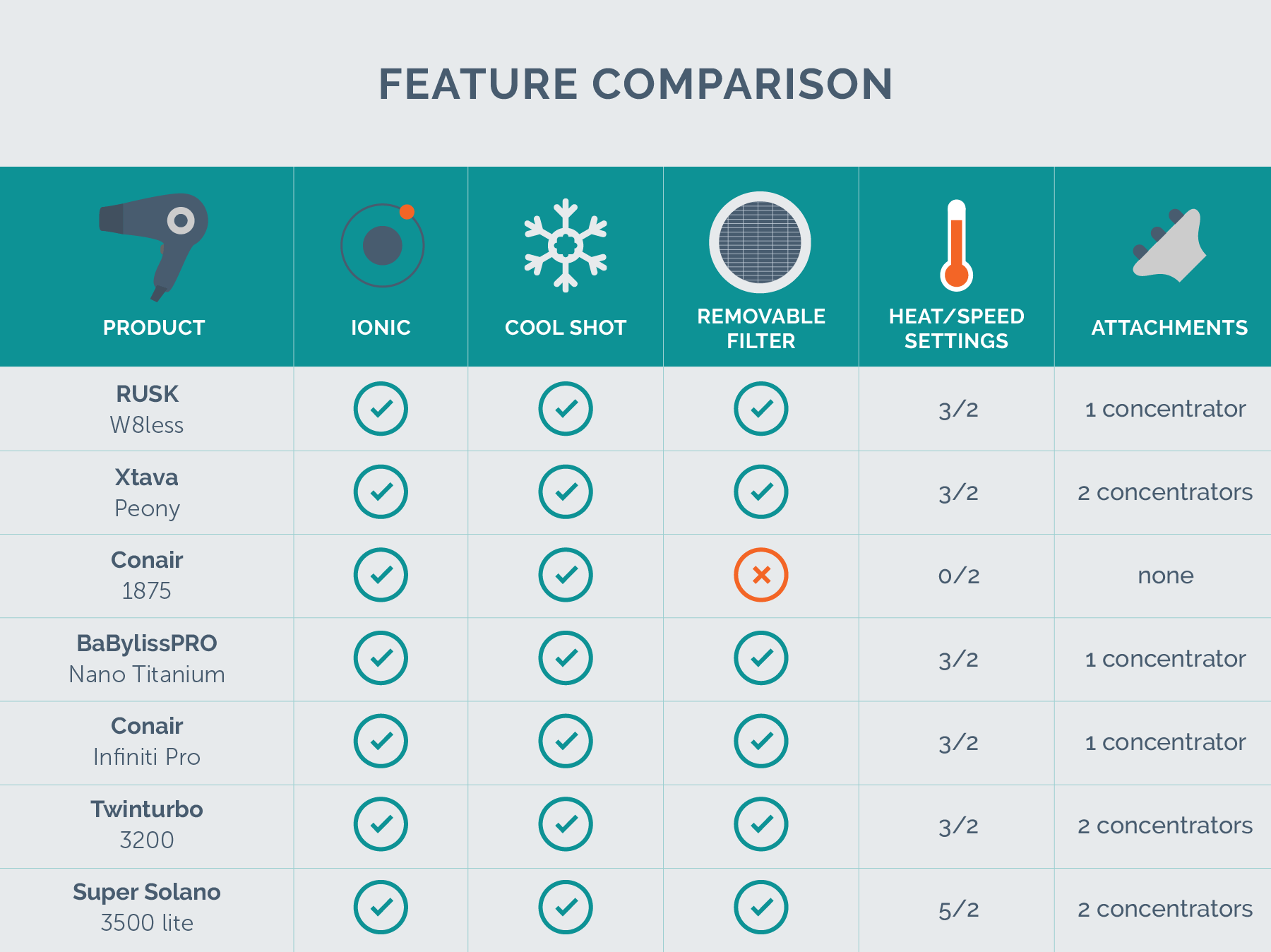
Ionic: Water ions are positively charged, so ionic dryers create negative ions to help break down water molecules before they soak in. This science combats frizz and allows for much faster dry time.
Ceramic coating: The heating elements of ceramic dryers are made of coated ceramic (a composite material usually made of clay), so they emit non-damaging, far-infrared heat. Hairstylist Lance McBrayer,\ explains that the infrared spectrum of light is invisible to the eye, but penetrates further than visible wavelengths because it directly heats objects in an area without heating the entire space. Far infrared heat is unique because it penetrates the hair shaft, making it the most efficient, gentlest way to heat hair. Ceramic also has unique heat conducting properties, so it heats up more quickly and evenly than dryers with metal or plastic heating elements.
Titanium coating: Similar to ceramic (but lighter) titanium is used to distribute heat evenly. This is due to the metal’s ability to maintain a high, constant temperature, which also means faster drying and less damage to hair.
Tourmaline coating: Tourmaline dryers are made or coated with crushed crystals of the semi-precious mineral tourmaline, which distributes negative ions when heated and leads to a shinier, less frizzy finish. It has been found to dry hair 40% more quickly than a hair dryer without tourmaline technology.
Wattage: Glamour reports that a high-wattage motor means more wind power and less heat damage. Celebrity stylist, Ryan Richman, recommends a hair dryer that falls within the 1300 to 1875 watt range for home use.
Variety of heat/speed settings: As we mentioned earlier, heat levels should be adjusted to suit your hair texture, condition and the amount of time you have before heading out the door. If you’re sharing your dryer with someone else, it’s especially important to have a dryer that has enough settings to meet both of your needs.
Cool shot button: Cold air seals the hair cuticle, leaving a smoother surface that reflects more light (i.e. shiny hair). It also locks in style and curl, and protects against overheating.
Attachments: If you have curly/wavy hair or want to control the style outcome, using an attachment such as a concentrator or diffuser will give you better results. A diffuser distributes heat broadly, adding bounce and body. Concentrators direct and focus the air output, which helps prevent frizz.
Removable filter: Cleaning out dust and debris buildup from the filter extends the motor life of your hair dryer. It’s fairly similar to cleaning out the lint filter in your clothes dryer. According to Self, you should clean your hair dryer vent weekly. The dryer can pose a fire risk if you don’t regularly clean it, so a removable filter that makes the process easy is key.
Usability: A user-friendly design is something to take into consideration when choosing a hair dryer. It should be easy to handle, relatively lightweight, and have buttons placed in a logical position. Cord length and storage are other factors that can make a hair dryer a positive or positively annoying experience.
AC vs. DC motors
AC motors are heavy-duty, long-lasting motors that are known for their powerful airflow, quality, and performance. The cons to using a dryer with an AC motor are that it is larger and heavier, and they tend to be more expensive.
On the flip side, DC motors are smaller and lighter. However, they are less powerful than an AC motor. They have a shorter life span, performing for approximately 400-700 hours, but are generally more reasonably priced.
Damiano Petruccelli, US Sales Manager for Turbo Power Hair Dryers, has said, “The first thing you look for is AC motor vs a DC motor; AC will outperform DC in every aspect.” However, The Beauty Department points out that there are always exceptions to the rule, so it’s worth it to read the reviews before deciding against a dryer simply because it has a DC motor.
We tested three hair dryers with DC motors and four with AC motors. After testing and comparing our finalists, we found that the generalizations of AC vs. DC motors didn’t really pan out. You can find a lightweight, budget-priced hair dryer with an AC motor (like the Xtava) or splurge on a professional hair dryer with a DC motor (like the Super Solano – 3500).
Unless you’re using it in a salon, you probably don’t need to invest in a more expensive model simply because it has a longer-lasting motor. In terms of power, two of our finalists with the highest wattage (the Rusk – W8less and BaBylissPRO – Nano Titanium) have DC motors.
The bottom line
Since hair texture and style vary, it’s hard to name a one-size-fits-all hair dryer. However, the Rusk – W8less was the most ideal for all types of hair. It excelled in every one of our tests, and met nearly all the key metrics we used in testing. With a high-wattage motor and plenty of wind speed, it makes a blowout fast and simple, so you can spend less time getting ready and more time on important things like breakfast. Infused with ceramic and tourmaline, it causes less stress on your strands and provides shinier, smoother results.
The BaBylissPRO – Nano Titanium is another solid choice, unless you have more damage-prone hair that could be distressed by the very hot temperature of this dryer.
More Reviews
AquaBliss - SF100
Johnny B - Mode
American Crew - Defining Paste
Xtava - Twist Conical Curling Wand
The 8 Best Hair Straightening Brushes
MiroPure - 2-in-1
GVP - Ceramic Titanium
Moen - Magnetix Attract
Panasonic - ES-LL41-K
The 7 Best Hair Straighteners for Thick Hair
BaBylissPro - Nano Titanium
Cottonelle - Ultra ComfortCare
Munchkin - STEP
JuJuBe - B.F.F.

